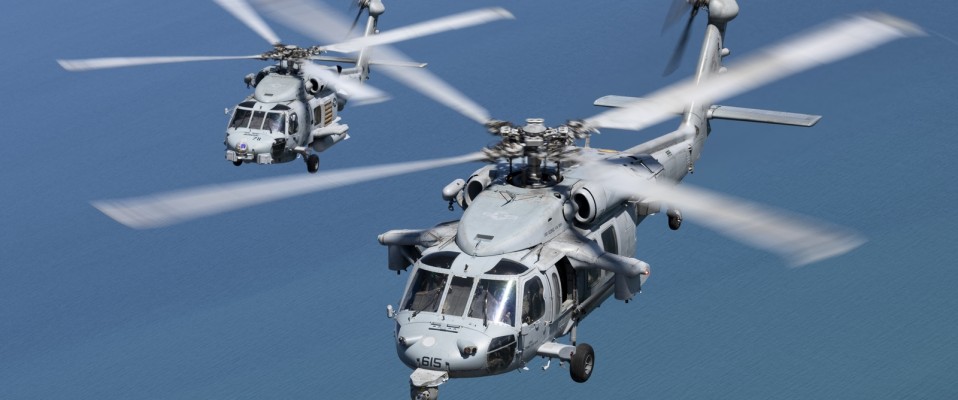MH-60R Seahawks: “Hunting for Whales”
Report and photos by: Patrick Roegies, Jurgen van Toor, Ben Gorski & Paul Gross
February 4, 2024
Introduction
Anti Submarine Warfare is a vital capability that is fulfilled by multiple assets within the United States Naval Aviation. The MH-60R Seahawk is one of these vital assets and as a part of the Carrier Air Wing capable to pinpoint any possible contacts that might pose a threat to the fleet. The MH-60R Seahawk can be configured for any specific mission which means the helicopter can easily be adapted to the challenges that lie ahead.
Lt. Reagan Stromback, was trained while assigned to Fleet Replacement Squadron (FRS) Helicopter Maritime Strike Squadron HSM-40 “Airwolves” based at NAS Mayport mostly training from Jacksonville, FL and is currently assigned to HSM-71 Raptors based at NAS North Island. Upon successful completion of her training LT Stromback transferred to HSM-71 “Raptors” operating the MH-60R Seahawk.
HSM-71 “Raptors” is a Naval Aviation helicopter squadron based at Naval Air Station North Island. The “Raptors” are currently assigned to Carrier Air Wing Nine (CVW-9) and deploy to CVN-72 USS Abraham Lincoln.
The squadron was formed on 04 October 2007 and was the first fleet squadron to receive the MH-60R Seahawk. The squadron received its first Battle “E” two years later in 2009. The Navy “E” Ribbon denotes the wearer was on permanent duty aboard a U.S. Navy ship or in a unit that won a battle efficiency competition, and was also awarded the Captain Arnold Jay Isbell Trophy for superior air anti-submarine warfare (ASW) in 2009 and again in 2010. Among other awards, in 2022, HSM-71 won the Admiral J. S. “Jimmy” Thach Award, awarded for outstanding achievements and contributions to naval aviation as well as 2022 Battle “E”.
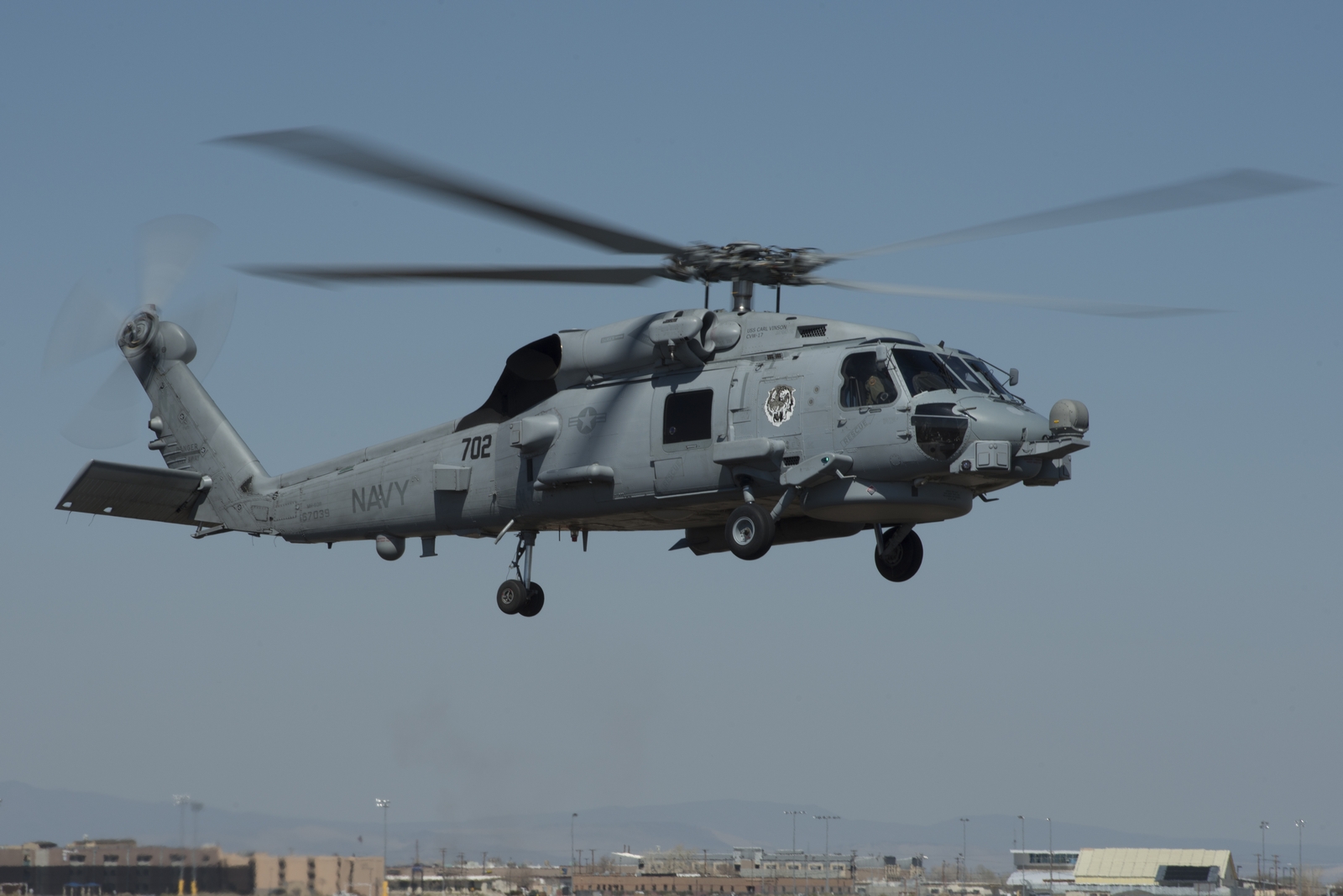
Romeo and Sierra
The main difference between a MH-60S and a MH-60R Seahawks are the sensors the helicopter is equipped with, LT Stromback explains. The MH-60S “Sierras” crews are highly capable pilots and the MH-60S, just like the MH-60R are, really state-of-the-art helicopters. The “Sierras” as the MH-60S is referred to, primarily are used for search and rescue (SAR) and logistics. However, the full mission profile for the MH-60S Seahawk include Anti-Surface Warfare (ASuW), combat support, humanitarian disaster relief, combat search and rescue, aero medical evacuation, special warfare (SPECWAR) and organic airborne mine countermeasures. They help train seals, and I’m sure they do a fantastic job performing their tasks”. The “Romeos” roles include all of the aforementioned missions with the addition of Anti-Submarine Warfare (ASW), and Intelligence, Surveillance, and Reconnaissance (ISR) and Electronic Warfare (EW).
The US Navy Seahawk fleet is divided over the Atlantic and Pacific fleet. The table below presents where the MH-60R or “Romeos” squadrons are located. The Pacific Fleet has the Romeos basically concentrated at NAS North Island with a couple of squadrons located at other bases like MCAF Kaneohe Bay and forward Naval Air Stations like NAS Atsugi. The majority of the squadrons are located a Naval Air Stations NAS Jacksonville and NAS Mayport both in Florida.
| Home base | Squadron | Nickname | Types in use | Modex | Emblem |
| NAS Jacksonville | HSM-46 | “Grandmasters” | MH-60R
MQ-8B |
HQ-xxx |  |
| HSM-60 | “Jaguars” | MH-60R
MQ-8B |
NW-6xx |  |
|
| HSM-70 | “Spartans” | MH-60R | AJ-70x |  |
|
| HSM-72 | “Proud Warriors” | MH-60R
MQ-8B |
AB-7xx |  |
|
| HSM-74 | “Swamp Foxes” | MH-60R | AC-70x |  |
|
| NAS Mayport | HSM-40 (FRS) |
“Airwolves” | MH-60R | HK-xxx |  |
| HSM-48 | “Vipers” | MH-60R | HR-xxx |  |
|
| HSM-50 | “Valkyries” | MH-60R | HV-5xx |  |
|
| NAS North Island
|
HSM-35 | “Magicians” | MH-60R MQ-8B |
TG-3x |  |
| HSM-41 (FRS) |
“Seahawks” | MH-60R | TS-4xx |  |
|
| HSM-49 | “Scorpions” | MH-60R | TX-xxx | 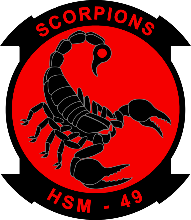 |
|
| HSM-71 | “Raptors” | MH-60R | NG-7xx |  |
|
| HSM-73 | “Battlecat”s | MH-60R | NA-7xx |  |
|
| HSM-75 | “Wolfpack” | MH-60R | NH-7xx |  |
|
| HSM-78 | “Blue Hawks” | MH-60R | NE-7xx |  |
|
| MCAF Kaneohe Bay | HSM-37 | “Easy Riders” | MH-60R | TH-xx |  |
| NAF Atsugi | HSM-51 | “Warlords” | MH-60R | TA-7xx |  |
| HSM-77 | “Saberhawks” | MH-60R | NF-7xx |  |
|
| NAS Rota | HSM-79 | “Griffins” | MH-60R | HG-7xx |  |
Continuous training
When the squadron is not on deployment the aircrews train on a regular basis to gain experience and keep current on the wide variety of systems on board the MH-60R Seahawk. LT Stromback explains; “We have to perform flights to keep current and just to stay practicing. We have a minimum number of hours that we have to fly, to ensure that we are safe. And sometimes we’ll have specific missions. Yesterday, I flew a three and a half hour bag, we refer to flights as “bags”. On our flight we were conducting anti-submarine warfare training with a remote-controlled submarine, utilizing sonobuoys and our dipper to track it. On deployment, you’ll typically fly double bags, so six hour flights, you go out for three hours probably come back and fill up on gas and go back out. The length of flight largely depends on what mission you are conducting. For carrier strike groups, the standard is to have 24-hour coverage. To accomplish this, there is a Romeo flying, monitoring radar at all times. Endurance is dependent on load out, but typically, you can go about three to four hours without refueling depending on what profile is, and whether or not the aircraft has an auxiliary tank. Here, while homeguard, we typically fly about three hour flights for day to day currency and training”.
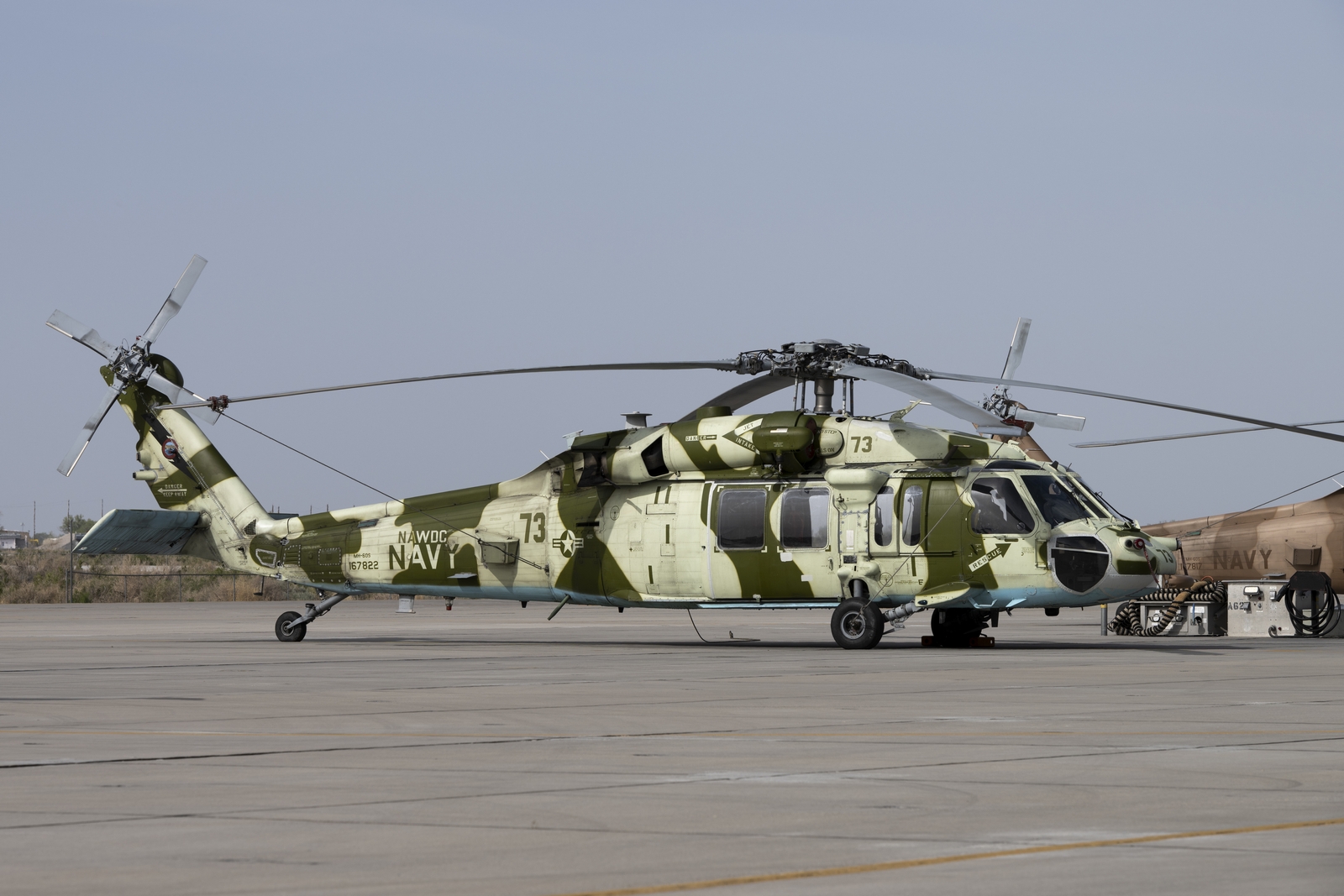
Tailor made configured LEGO set
The primary missions assigned to the MH-60R are anti-submarine warfare (ASW), anti-surface warfare (ASuW) and Electronic Warfare (EW). LT Stromback continues “the Helicopter employs radar to see what’s going around us so we can let the ships and the aircraft in the fleet know, providing them with enhanced situation awareness. Additional sensors we have include our electronic warfare suite, which further increases our ability to identify what vessels are out there.”
“Essentially, our sensors can listen to the electronic signals unknown vessels are emitting, which can give us an idea of who they are. That’s the base of it”. LT Stromback further explains that the secondary missions, search and rescue (SAR), medical evacuation (MEDEVAC), vertical replenishment (VERTEP), communications relay (COMREL) and naval service fire support (NSFS) are also conducted by the HSM squadrons, and are also frequently trained to.
“As Romeos, we are able to configure our aircraft as necessary, in that we’re kind of like a Lego set or a Jeep. You can take us apart to some degree and put it back together adding whatever accessories, features or capabilities you need for whatever mission is at hand”.
“For instance yesterday, I flew a sortie where we were shooting out buoys. For this specific training mission we added the buoy launcher, which our maintainers can take off if we need to do search rescue overwatch or maximize the available space in the helicopter. We can also install the dipper (also known as “ALFS” Airborne Low Frequency Sonar), which essentially is a sensor that we dip into the water that emits energy. It receives the returned emitted energy to analyze what is surrounding the dipper. This dipper system is fully removable as well.
As the MH-60 is a multifunctional platform there are a number of different capabilities that can be integrated or removed, but there are systems that are that are “fixed” to the MH-60R configuration as well. These fixed systems are the multimode radar on the bottom, the multi-spectral targeting (MTS) system and the various antennas. The fixed configuration also includes a Forward Looking Infrared (FLIR) camera. Additionally the helicopter is equipped with a wide array of Electronic Support Measures (ESM) detectors.
LT Stromback also explains there is a wide variation of different configurations and depending on the mission the Romeo can be modified to perform the specific mission for that sortie. “We can also take on external fuel tanks to extend our mission time at sea. Obviously, the external fuel tanks make us heavier, so we have to keep in mind if this additional weight is going to help us or hurt us.” Last, but not least, the MH-60R Seahawk is also able to carry torpedoes, rockets and missiles. LT Stromback continues; “We are what we call a “Pouncer” platform. We will never be sent out to destroy a ship, but we can launch an attack on an adversary vessel if need be. Our attacks are typically used more as deterrents to make them rethink what they’re doing, or damage them to inhibit their ability to continue their current course of action. However we can be lethal against smaller targets as necessary.”
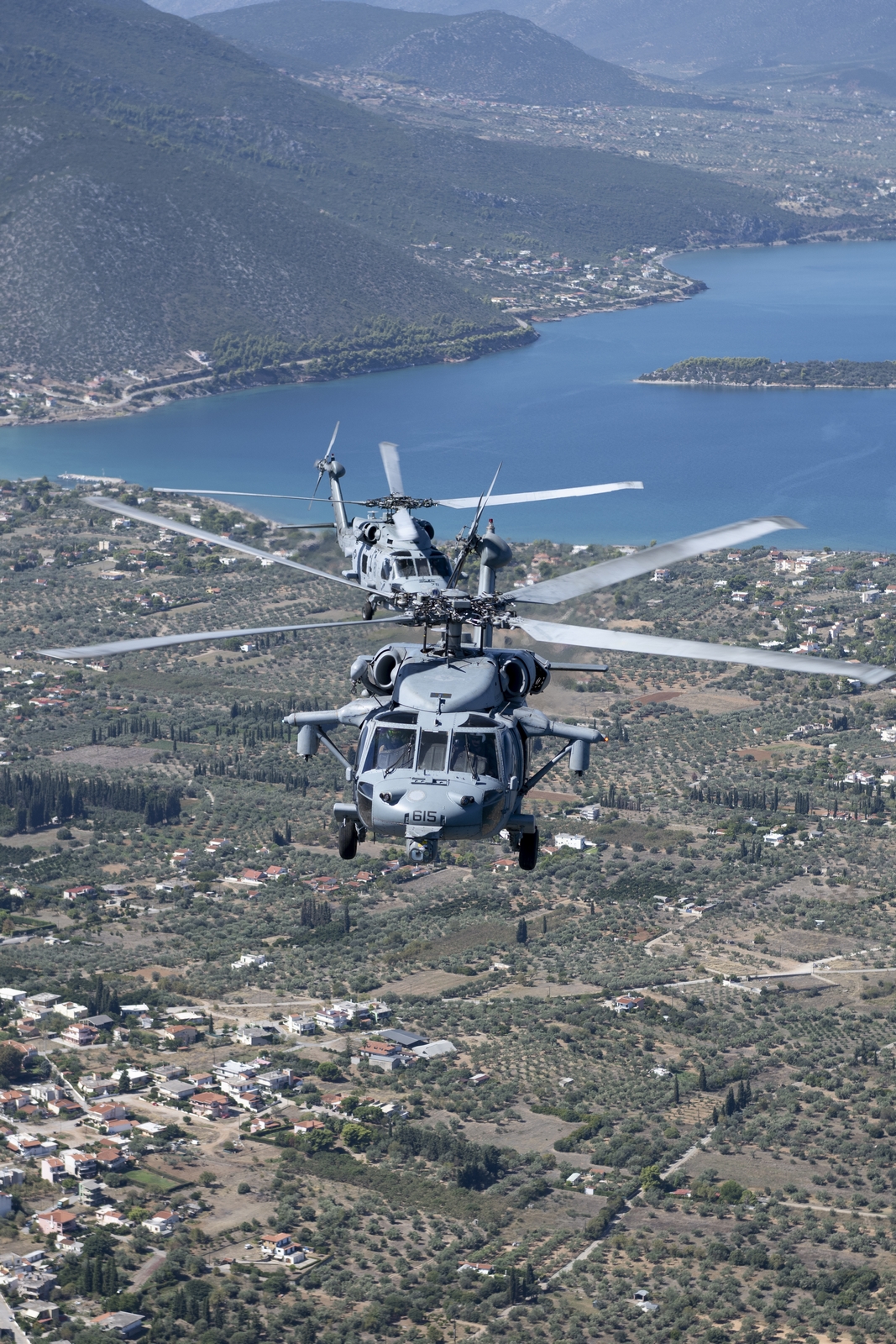
Deployments
The MH-60S and MH-60R Seahawks are regularly deployed to sea. “There is a difference between a carrier squadron, assigned to a Carrier Air Wing (CVW), and an expeditionary squadron. The Carrier Squadrons are an integral part of the carrier strike group. This means, whenever the Carrier Strike Group deploys, we’re going to be going out with them, it’s usually a pretty set schedule, and you’ll be going out for relatively long deployments. Expeditionary deployments are typically shorter and not as set in stone or known ahead of time compared to a carrier squadron”. So, for example, expeditionary squadrons can be deployed on a Littoral Combat Ship (LCS), or independently steaming destroyer, and an average deployment takes approximately 3-5 months whereas a deployment to a Carrier Strike Group can last up to 9-10 months at sea. “As the Expeditionary Squadrons are not attached to a Carrier Air Wing their schedules are more dynamic and don’t have as much free knowledge of when they are going to be deployed. But they’re typically shorter engagements. They’re pretty versatile, because they can augment squadrons as necessary, which is pretty helpful, especially in times like these. They are an excellent asset.”, according to LT Stromback.
The number of deployed MH-60R Seahawks depends on the type of deployment LT Stromback continues. “We typically bring about five Romeos for the carrier deployment and two Romeos for a destroyer, or cruiser deployment. Typically, one to two crews are deployed for each aircraft deployed. The crew of a MH-60R Seahawk consists of a helicopter aircraft commander, a second pilot, designated as H2Ps, and one or more Aircrewmen. The Aircrew are our sensor operators and rescue swimmers.” LT Stromback comments; “I can’t talk them up enough. They’re incredible. They’re incredibly intelligent and experienced, and they have to be intelligent to conduct our anti sub missions and have to be athletic so that they can actually perform the search and rescue tasks. They truly are the best sensor we carry. They are the onboard subject matter experts for a large part of the missions we conduct. While ASW and ASUW are our primary missions, they train very hard to stay experienced in search and rescue, which is incredibly demanding. We recently passed a SAR inspection with flying colors, we scored higher than the last 5 or so squadrons who were inspected, which included Sierra squadrons”.
“With the extended carrier deployments, obviously, anytime you’re away from family is difficult. The Navy has been making strides to make it a little less, negatively impactful. Some carriers are trying to get some type of Wi Fi onboard, so that you can at least message your family, which is a great way to stay in touch with the home front.”
“There’s also e-mail on board. That’s typically how you can communicate. But in general, at the end of day, we did sign up for this, we all knew this was kind of an option. I know I have friends on the East Coast, too. Their commanding officer prepares the crew as well as he can by communication they are supposed to be gone for eight months, but plan for eleven months. But it definitely does take a toll, but the COs and XO’s are highly aware of that. They do a great job to really make sure that everyone feels welcome and is heard. But obviously no one likes to hear that you’re going to get extended three more months”.
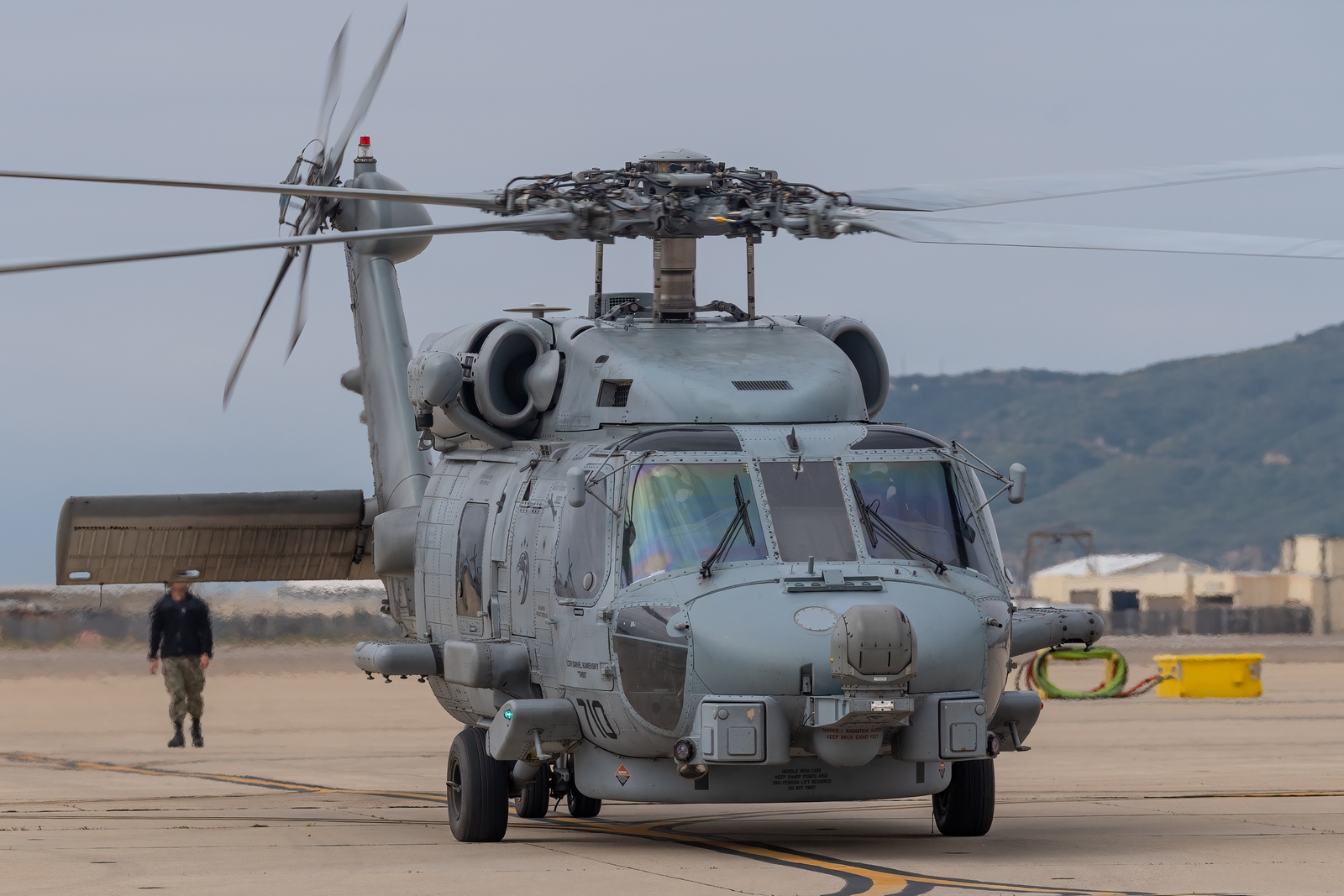
Keeping them up
“In terms of the deployed aircraft, we have incredibly capable maintainers on board during our cruise. We typically bring out everything they may need to do their large inspections, but obviously that is a ton of material. It’s a lot of stress on the aircraft, aircraft lifespan and inspections and maintenance are determined by the operational hours flown. So if you’re flying more and more obviously the helicopters are put into phase or they had to go through inspections sooner.
“The maintenance team typically have everything they would need on the ship to conduct the fore mentioned inspections and servicing. They try to conduct large inspections/maintenance jobs prior to going to sea so they don’t have to do it at sea, they can do something called rebasing which resets the clock”.
Anytime they need specific parts we have the Carrier on Board (COD) delivery which was previously performed by the C-2A Greyhound and is currently performed by the CMV-22B Osprey at this point. The ospreys will pick up the required parts in port, and transport them to the Carrier.
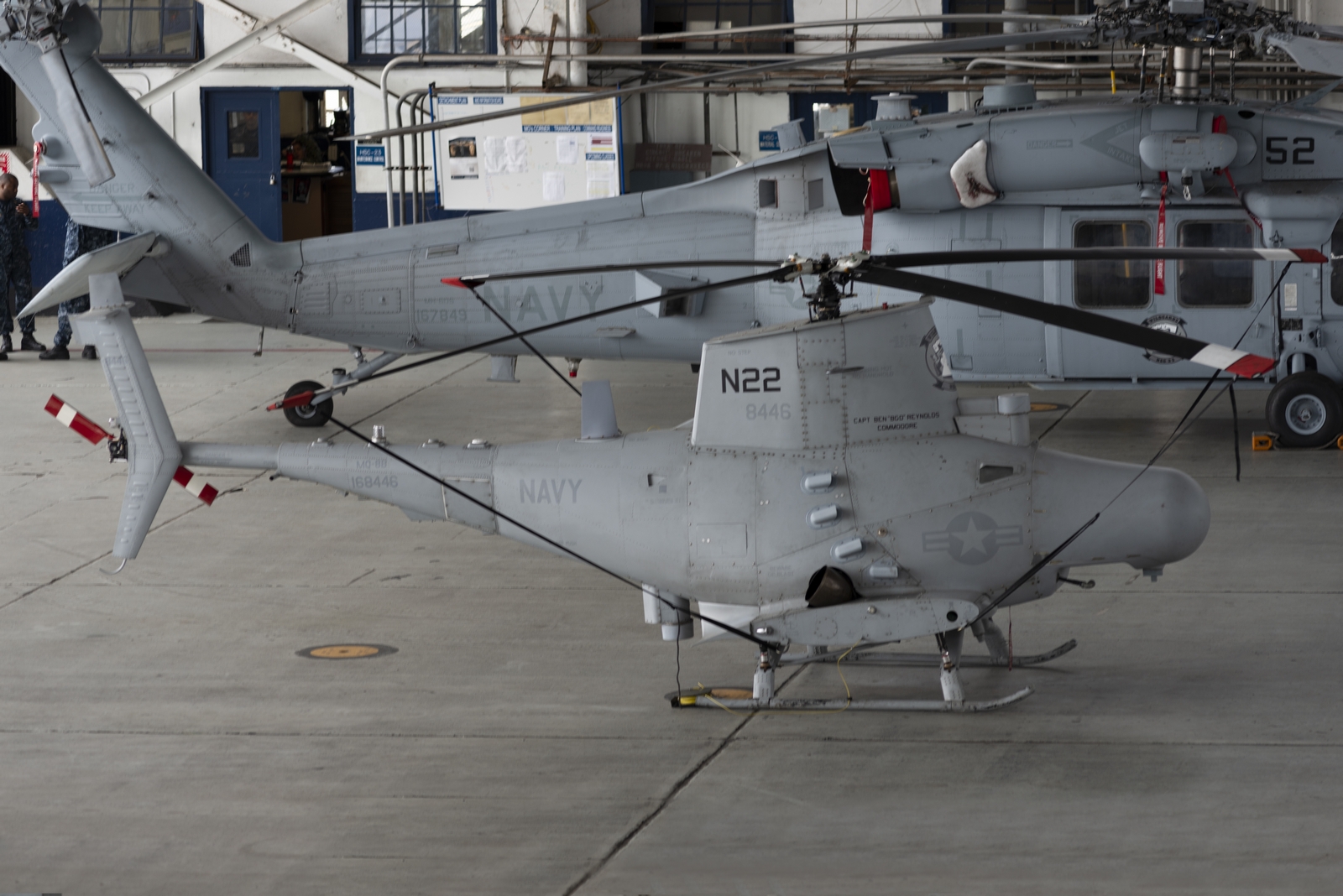
Sub-hunting
LT Stromback further explains the primary mission of anti-submarine warfare (ASW) assigned to the MH-60R Seahawk. “We’re primarily sub hunters, but we’re not intended to be sub-killers, if that makes sense. We are able to carry torpedoes, which we would use against submarines, and missiles and rockets, which would be used against surface ships. We can carry a combination of both AGM-114 (Air-to-Ground Missile) Hellfire missiles and APKWS (Advanced Precision Kill Weapon System) rockets. We can carry these on our external pylons. The Torpedoes we are capable of carrying are the MK-46/54.
“The MH-60R Seahawk is equipped with an integrated self-defense system, which alerts us to any incoming missiles, and it even provides an early warning in the event we are being targeted. Compared to the Strike Fighter assets we can’t do that much, but we definitely have our maneuvers”.
The MH-60R Seahawk is also equipped with aircraft survivability equipment. “If we are out there on a mission, there is a possibility someone is targeting us. The electronic signals used to target us are detected and will show different symbols on our monitors. We are trained on the different types of targeting and know how to evade each possible threat. We are also equipped with self-defense systems, we have chaff dispensers, chaff essentially being small shards of aluminum, and we have flares. Our Integrated Self Defense (ISD) system has modes that will automatically activate if it senses certain things. The helicopter will protect itself in a lot of ways. And then the crew will take it further from there.”
“There are different ways that we can speak to the submarines and realistically, we certainly hope if there is an adversary submarine set up out there, there’s an American tail on it. It is imperative to know where the adversary submerged assets are at all times. That is kind of how this game works, you want to always know where they are, but also the other adversary naval vessels are tracked at all times.
“We are limited by what we are able to carry weight-wise. So our torpedoes aren’t going to be as hefty as would be required to definitely sink a submarine. So again, if we hit them, it’s not necessarily going to kill them. But it could crack the hull, which could severely impact their operations”.
“One of the things that makes us so good at sub hunting is our Automatic Radar Periscope Detection and Discrimination (ARPDD). Essentially, this radar is so good that it can detect a balloon in the ocean. It is able to sense a periscope even at great distances. It will be able to not only detect it but it can also determine and alert the crew to a probable periscope. This is actually how we find the majority of the submarines”.
“We are also able to use this radar for search and rescue which is incredible. If there is a person in the water, this radar will 100% pick them up and it will separate them by what size targets to give us a clue so small, large medium. So if we are looking for a person in the water we can see a small target pop up on radar, and depending on the range, we can visually check it with our FLIR. Again, they have a discreet symbol for submarines so we don’t just confuse them as sea clutter”.
“Alternatively there are a lot of different radar modes. Some modes that are good for longer distances. They can kind of see everything that’s out there, but won’t be as good on detail level, but it has pretty good range, approximately 160 miles, especially with if you have favorable weather conditions.”
“Weather and environmental circumstances play a big role in our ranges. Prior to every flight we brief what kind of weather we’re expecting, and when doing a mission we will brief how that will affect our sensors and what ranges we are predicted to have.”
The APS-153 multi-mode maritime surveillance radar (MMR) is a light-weight airborne multi-mode radar capable of surface search, IFF interrogation and inverse synthetic aperture radar (ISAR), which is the new version of the APS-147 originally developed for the SH-60R and remanufactured for the MH-60R Seahawk. The APS-153 advanced radar can scan in six different modes. This includes the modes, search coastal, search short, search long, periscope short, periscope long, ISAR and ARPPD. The IFF interrogation can also be used in different modes. These modes are obviously bound by sometimes their specific limitations, and so we might have to swap between the different modes to get a clear and exact assessment what is out there. But the radar on the “Romeo” is very good. And then the identification friend or foe (IFF) interrogation can help us further identify a newly detected contact.
“With regards to expendable sensors, we have DIFAR (Directional low frequency analysis and recording) sonobuoys for passive sonar, and DICASS (Directional command activated sonobuoy system) for active sonar. Our ALFS or dipper, is also one of our means of utilizing active sonar against sub surface tracks. We deploy a sonar transducer into the water and it sends out pings and absorbs the returns. The return sounds let you know if there’s something out here that the emitting sound signal is hitting, this will be shown on the helicopters display”.
“We utilize passive sonobuoys for localization, tracking and identification, and active sonar for localization and tracking. We have to be careful when we use our active sonar. The dipper emits a very high frequency signal, so we want to be conscious about the sea life and environment itself. But it is a highly effective means of prosecuting submarines. But once we start using active sonar, any submarines in the area will hear it. If we begin tracking them with active radar, they absolutely know that we know where they are, which sometimes we can use as a deterrent. Sometimes you don’t need to drop a torpedo to dissuade a submarine from doing something bad. Sometimes just them knowing that we know where they are is enough to stop them.”
“The electronic warfare support measures (ESM) system is a passive emitter detector, and we can identify and localize a wide variety of electronic signals. This system is used whenever we have detected an emitter of interest or a unique emitter. For instance we can expect to see a Nav-9, which is a navigation radar, or pretty much any ship out there. And it’s based off of frequencies that the system detects. So certain naval vessels will have certain frequencies that they emit. So that will help us go in if we’re looking for a particular naval vessel. We know the type of emitters that are unique of that specific vessel, so we can program that in our system when our sensors detect one of the unique emitters, our aircraft will automatically alert us. We are able to train for this in our flight simulators. I know it’s becoming a bigger and bigger deal in the real world.”
The AIS system is the automated information system. “It’s what you’re programmed to spit out about yourself. Each vessel is supposed to register and report, who you are, where you’re coming from where you’re going. However, they don’t always do that. If we’re looking for an enemy ship, we’re expecting that they will try to spoof AIS, so it will not be as helpful in that aspect. But if we are simply flying around to get a surface picture for the ship we are attached to, and our radar picks up a large surface contact, we can see from AIS that it is, for example, a container ship leaving one port for another. We can corroborate this with our other sensors to determine if it actually is what is claims to be.”
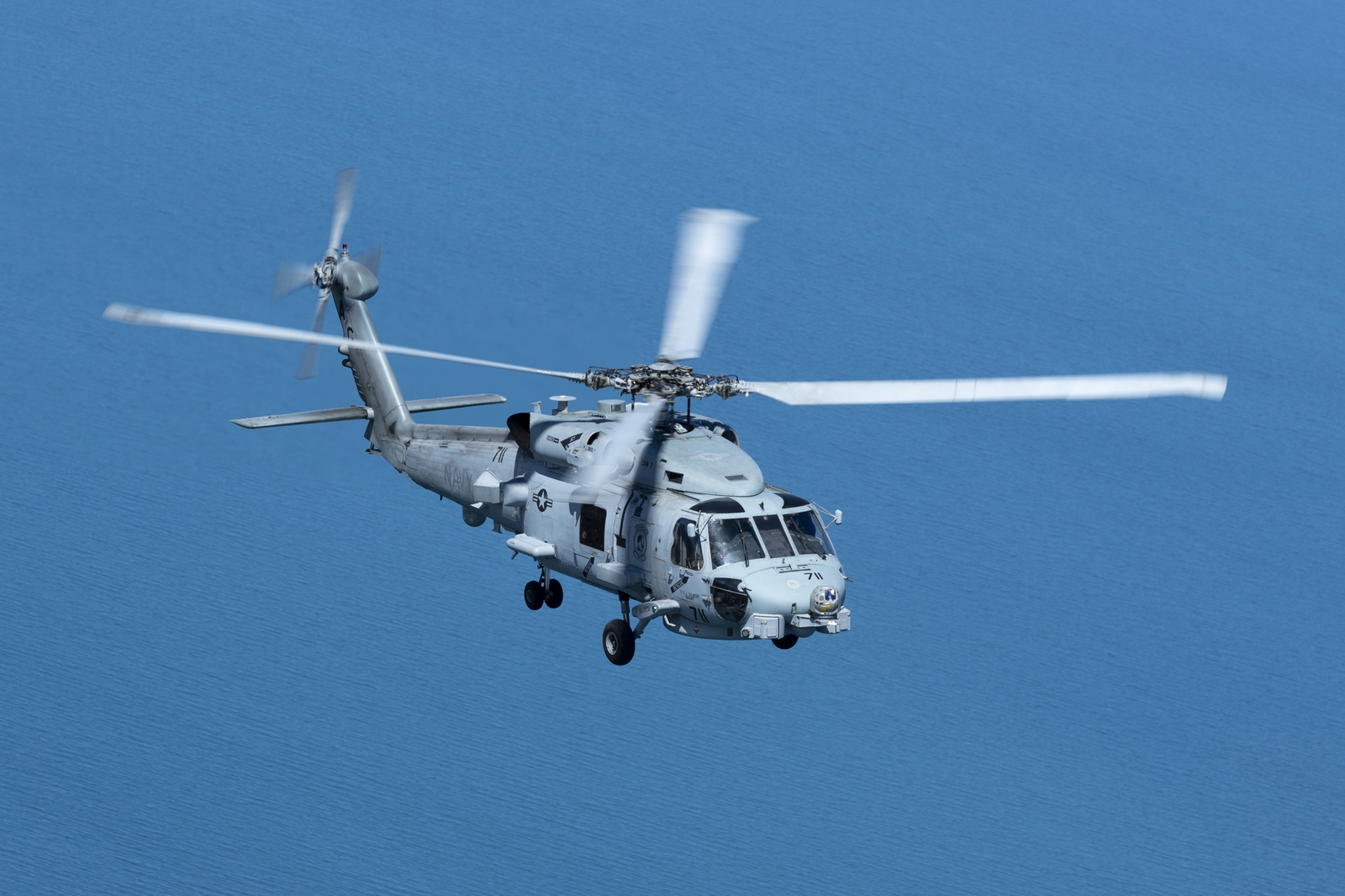
All pieces of the puzzle generate the bigger picture
The Romeo and Sierra Seahawks are able to coordinate with other assets. “We can talk to the F-35C Lightning II, F/A-18 E/F Hornets, EA-18G Growlers , P-8A Poseidons, E-2C/D Hawkeyes, MV-22 Ospreys and drones. And obviously, we can talk to ships, we have the means to be able to speak directly to the ships and aircraft carrier via a secure line. And then we have a system called Link-16 that allows us to speak to all the players and we can all push what we’re seeing into the same system, so everyone can actually share what they see.
So if one of our other assets sees something, they can push it down link 16, and that allows for everyone in that network to gain a better picture of what is around them. which assists in general situational awareness and safety. Each asset has different strengths, and when we can all share our strengths it allows us to generate the bigger picture and enables us to assess what we are actually dealing while deployed at sea”.
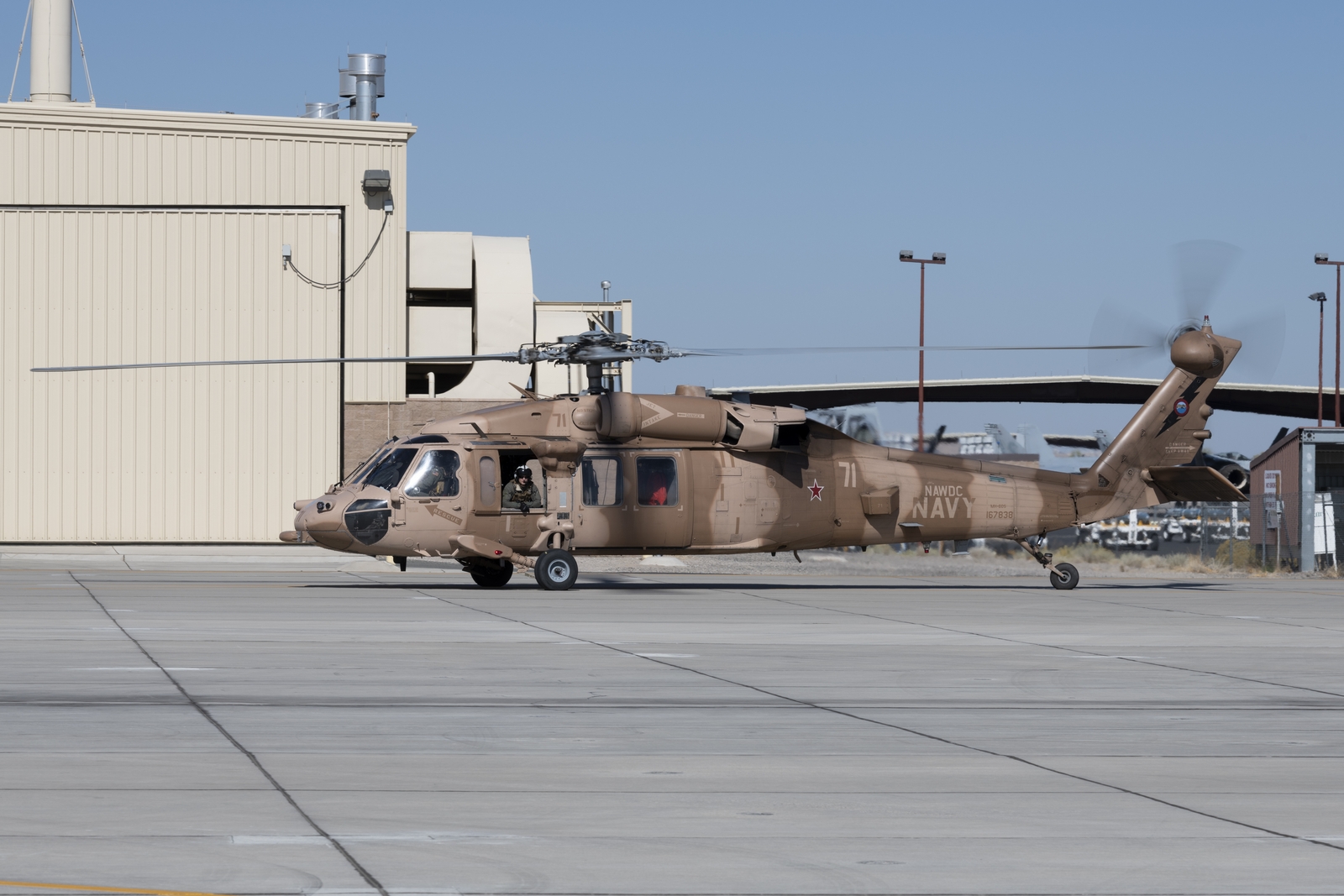
Carrier Air Wing of the future – the lessons learned
Between 02 August 2021 and 14 February 2022, The MH-60R squadron HSM-78 “Blue Hawks” assigned to Carrier Air Wing 2, was on a deployment with CVN-70 USS Carl Vinson. This cruise referred to as the Carrier Air Wing of the future cruise, was the first deployment that included the F-35C Lightning II and the E-2D advanced Hawkeye. The MH-60S squadron deployed during this cruise was HSC-4 “Black Knights”
With the enhanced capabilities of the new E-2D Hawkeye that increased scanning capabilities, the F 35C Lightning II are equipped with additional state-of-the-art communication capabilities and electronic scanning capabilities as well and the introduction of drones. Does this affect the MH-60R Sea Hawk operations?
LT Stromback explains that these capabilities enable the Seahawk crew to access more information and actually send and receive the data from other assets on their own monitors. “It absolutely enhances our ability to train together as a team and to fight together as team, we actually train to integrate with them. In our flight simulators we are able to simulate full mission profiles, where we will simulate that we’re working with an E-2C/D Hawkeye or a P-8A Poseidon, a jet, or even another ship. In the sim obviously, it’ll be an instructor making the calls and acting as the other asset, but it allows us to practice working with others and sharing intel. In the fleet, it is very beneficial to be able to have somebody overviewing at higher altitudes like the P-8s and E-2s. Due to the nature of our platform we can’t go that high, obviously. So typically, the P-8A Poseidon or an E-2C/D Hawkeye up there will relay their bits of information in such a way that it enables us to do some armed reconnaissance or surveillance and report the detailed information back to them and it has proven to be highly effective.
The radar system integrated in the MH-60R is pretty much comparable the surface search radar on the E-2C/D Hawkeye. The difference in application LT Stromback explains “We can go lower than them. They can go low, obviously. But The MH-60R typically operates lower, and if desired on a reduced speed so we can investigate things in more detail as our scanning time increases.
LT Stromback explains, “As this was the first cruise with so many new capabilities, there were lessons learned and information to be shared. For me personally, it has been largely transparent, because the entire time I have been training with the Romeo, we had training to coordinate with the other assets of the Carrier Air Wing. Starting during our training with the Fleet Replacement Squadron (FRS), we are coordinating with all possible other assets. It is a huge advantage to be able to coordinate between the assets and quite easily obtain the information they specifically have, or are gathering, so there is a maximum information availability at all times during the mission at hand. This is something that we absolutely try to train for as often as we can”.
With all this available information, do you ever have a problem with having too much information? LT Stromback continues: “Oh, absolutely. While talking to other aircraft, there is a possibility you have, pretty much six radios going off at any given time you’re communicating, you’re continuously switching between them. But that’s why we have a full crew during each mission we fly. So we are always going to be flying with two pilots and at least one aircrewman. Sometimes we take off with multiple Romeo’s. So there’s a lot of information flowing, but there’s also a large team capable of processing it. And then we have connections to the surface ships. So if we have things that we’re seeing, we can pass that information down to them, which enables them to investigate further on their end. Like if we send them some electronic warfare data, they can also look stuff up for us. So there is a lot of help out there, which is a good thing. Sometimes it feels overwhelming. But again, we train very hard to work together as a team to make it seem significantly more manageable and more usable”.
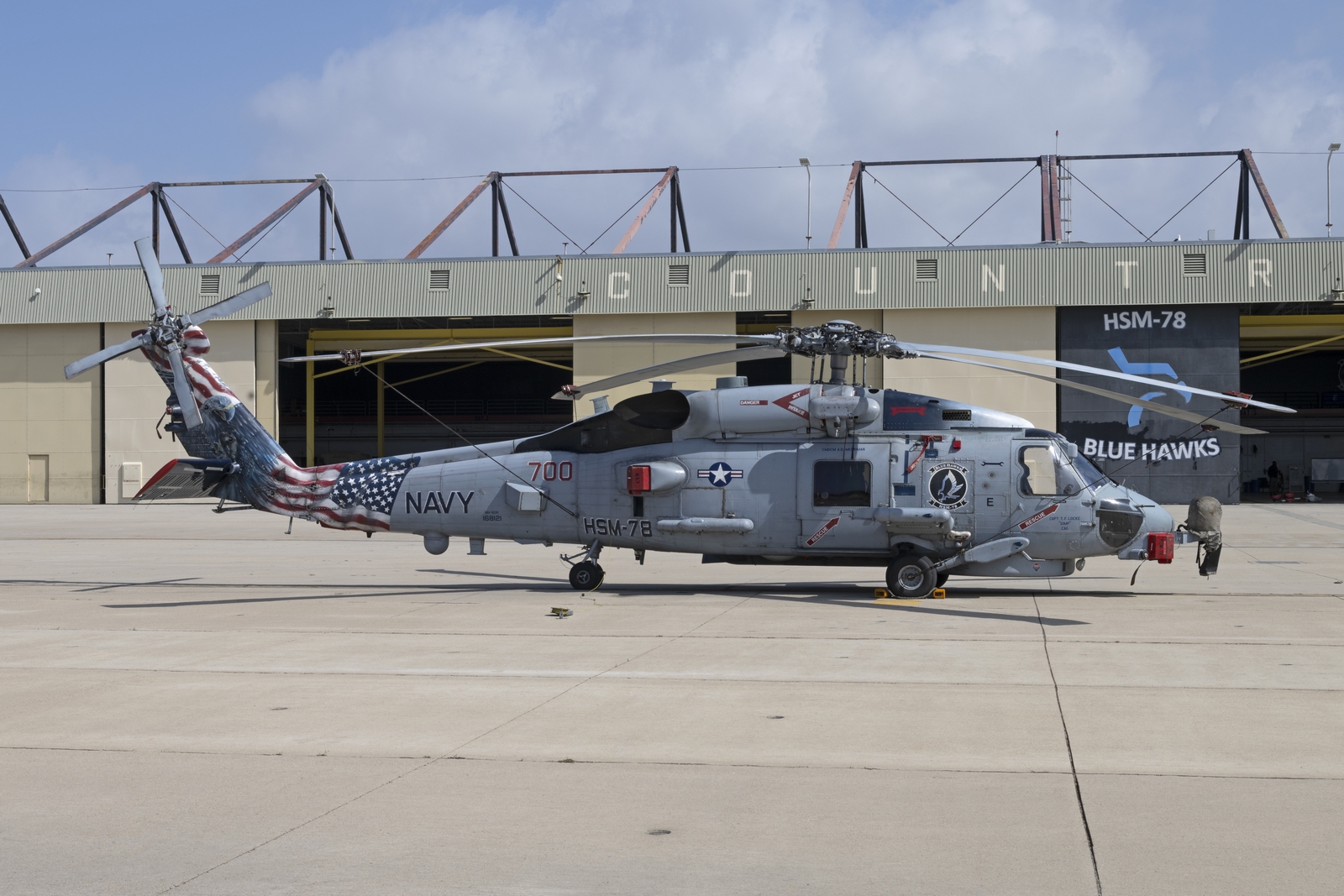
Cooperating with unmanned assets
We do train with drones, but currently the drones are very much going to be used as an augmentation. As far as I know they are never meant to be a replacement.
I don’t anticipate the Romeo will be replaced by drones on a short notice, but as the unmanned capability evolves down the road, many of the tasks can be transferred. I personally don’t expect The MH-60R Seahawk to be replaced by drones simply because our ability as a crew to go into the depth interpretation the information and prosecute. It really helps to be able to assess the problem from many information sources and analyze the results.
They’re very sophisticated, just hearing about what they plan to do with the drones into the future, it’s going to do awesome things.
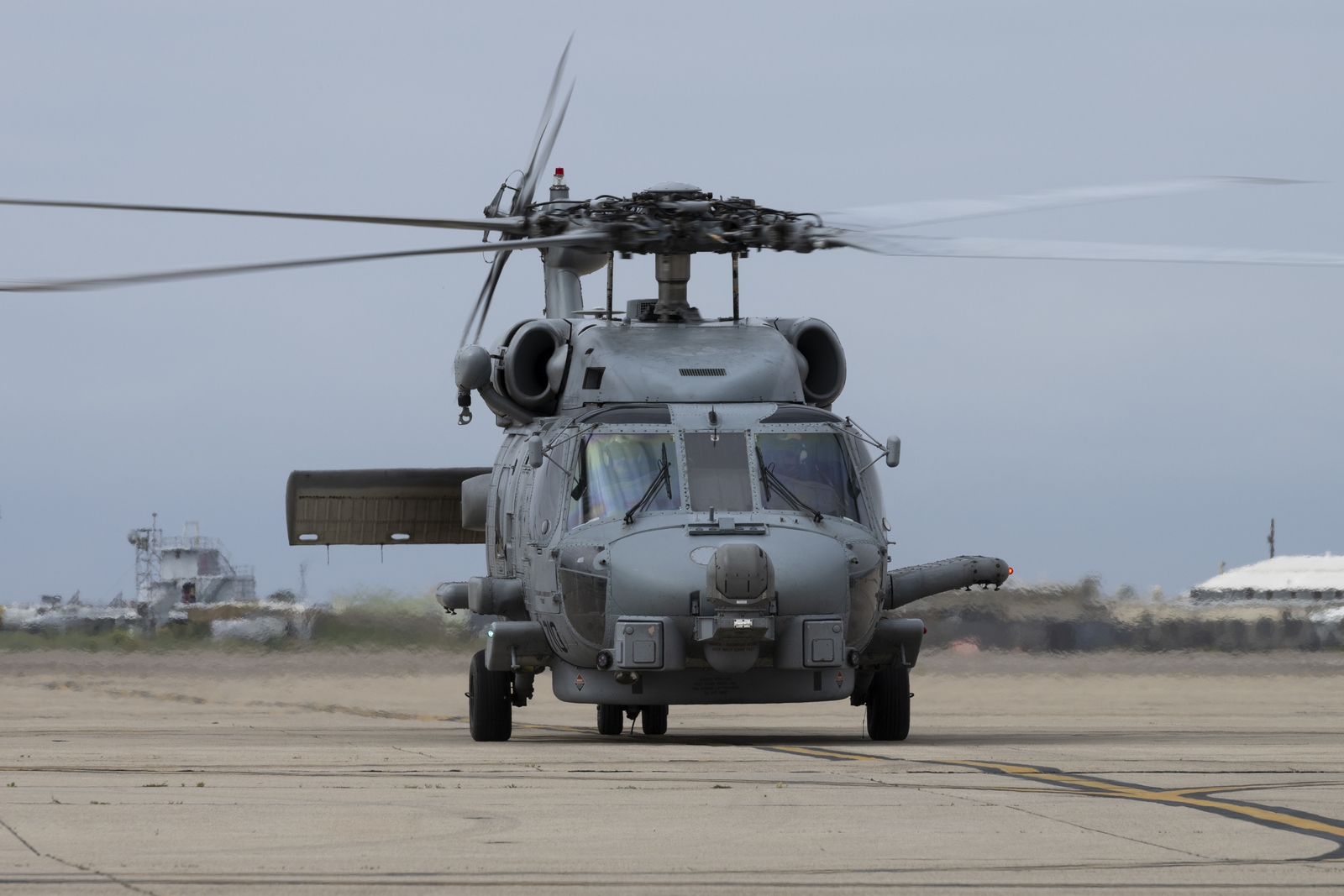
Going forward
The versatility of the MH-60R Seahawk will ensure the purpose and necessity of the use of the helicopters and their skilled crews to fulfill the Anti-Submarine Warfare early warning detection. Interlinked with the other assets in the carrier strike group the helicopter and its crew fulfills a vital role to anticipate any possible submerged adversaries.
The unmanned aircraft will play an increased role within Naval Aviation of the 21st Century. These unmanned assets will supplement the capabilities of the existing aircraft and helicopters assigned to the Carrier Air Wings. The interpretation and analysis of the data is still a task that requires human involvement, as the acquired information of the different systems of the MH-60R Seahawk requires a lot of interconnecting the dots. The information can easily be transferred, shared with naval vessels and other aircraft assigned to the carrier air wing via safe communication lines. This will enable the fleet commanders to base their decision based on the best available information in a real-time scenario. The MH-60R Seahawk will remain a trusted and vital asset to ensure the safety of the carrier strike groups for the mid-term period.
Patrick Roegies is born and raised in Tilburg, the Netherlands and currently resides in Sittard in the south of the Netherlands where he lives with his wife Joyce. Patrick graduated from a technical study at the HTS in Tilburg in 1997. He currently works as a head of an equipment engineering department in the south of the Netherlands.
His passion towards aviation started at the age of 7 in 1977 when his father took him to nearby Gilze Rijen Air Force base where he witnessed his first howling F-104 Starfighters which were practicing and as a result he got addicted immediately. The F-104’s were present in order to determine a tactic to create a diversion for the “train highjack” which was going on in the Netherlands at that time. The F-104’s were meant to create a diversion by performing an overshoot, kicking in the afterburner directly over the train, creating confusion with the hijackers and enabling the police to master the hijackers. This action has actually been performed and worked.
This is when his passion towards aviation was born. He got permission from his parents to visit the airbase every free hour he had and his father showed him the way by bicycle. Patrick got his first camera in 1984 which was a Canon T50 and shot Kodachrome 64 slides of mainly military aircraft. He changed his gear in the mid-nineties to Nikon and is a Nikon user ever since.
When Patrick obtained his driver license in 1989 he started to visit airbases all over Europe and from 1997 onwards he made worldwide visits to military airbases.
In order to further professionalize his work as an aviation photographer and journalist he started to write military aviation related articles based upon his visits to various nations and their Air Forces. He managed to publish his first article in 2003 and increased the numbers of publications every year.
Patrick can be reached at: [email protected]

